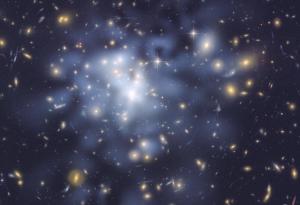Blog
A Dwarf’s Dark Tale
25 March 2024
 NASA, ESA, and D. Coe (NASA JPL/Caltech and STScI)
NASA, ESA, and D. Coe (NASA JPL/Caltech and STScI)If you have a view of the southern celestial sky, on a clear night you might see two clear smudges of light set off a bit from the great arch of the Milky Way. They are the Large and Small Magellanic Clouds, and they are the most visible of the dwarf galaxies. Dwarf galaxies are small galaxies that typically cluster around larger ones. The Milky Way, for example, has nearly two dozen dwarf galaxies. Because of their small size, they can be more significantly affected by dark matter. Their formation may even have been triggered by the distribution of dark matter. So they can be an excellent way to study this mysterious unseen material.
In a recent study, a team looked at dwarf galaxies to see exactly what they would reveal about dark matter.1 Specifically, they were interested in how dark matter might interact with itself. One idea about dark matter particles is that when they collide with each other they could emit gamma-ray light. This would mean that the central regions of galaxies should show evidence of gamma radiation without a clear astrophysical source. There have been some studies looking for gamma rays within our own galaxy, but the results have been inconclusive.
This new study focused on dwarf galaxies because they are smaller and therefore less likely to obscure gamma-ray light from colliding dark matter. There are also plenty of dwarf galaxies within our local group. Using 14 years of archival data from the Fermi-Large Area Telescope (LAT), the team looked at 50 dwarf galaxies. Overall they didn’t find strong evidence of gamma-ray emissions from any of the galaxies, but in 7 of them they found a small statistical excess at around 2σ - 3σ. To be definitive we’d like to see it at a level of 5σ, so this result is far from conclusive. But if we take the energy levels of the excess at face value, it would put the mass of dark matter particles around 30 - 50 GeV or 150 − 230 GeV, depending on the way dark matter might decay. By comparison, protons have a mass of about 1 GeV.
So once again a study of dark matter fails to discover the elusive particles. But as with earlier studies, this research narrows down what dark matter might be. Specifically, the study rules out certain mass ranges for dark matter more than ever before. It’s yet another small step toward solving the mystery of dark matter.
McDaniel, Alex, et al. “Legacy analysis of dark matter annihilation from the Milky Way dwarf spheroidal galaxies with 14 years of Fermi-LAT data.” Physical Review D 109.6 (2024): 063024. ↩︎